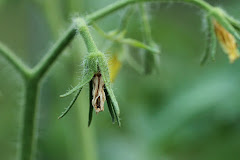 by guest writer Joel Reich*
by guest writer Joel Reich*Many Colorado gardeners have long lamented their inability to grow blueberries (Vaccinium corymbosum and related species). The problem stems from the fact that most of Colorado’s soils are slightly to highly alkaline, above pH 7.0 (neutral). Blueberries must have acid soils (a pH of about 5.5) in order to thrive. Unfortunately, there is just no practical way to manage Colorado soils in order to produce a pH that low.
The good news for blueberry lovers is that, with extra effort, there is a proven way to grow delicious blueberries in your Colorado garden. The keys to success are 1) plant the blueberry bushes in a medium that is primarily (or entirely) composed of sphagnum peat moss. This readily available material has a pH of approximately 5.5, so it is perfect for blueberries. Two further keys to success are: 2) make sure that the root zone always stays moist (even during warm, dry spells in winter), and 3) protect the bushes from drying winds during the winter. This can be done by wrapping the bushes with burlap or old sheets while they are dormant.
Any planting method that incorporates these three key elements should lead to success, so feel free to be creative. For those who want an established recipe for success, follow the instructions below. Keep in mind that you will need to have at least two blueberry plants of different varieties (for cross-pollination purposes) in order for the plants to set good crops.
For each plant:
- Dig a hole that is 20” deep, 30”long and 20” wide.
- Get a plastic-wrapped bale of sphagnum peat moss (3 cubic feet).
- Punch about a dozen holes in the bottom of the plastic wrap.
- Drop the bale, holes down, into your pre-dug hole. You can grow more plants in a row by dropping multiple bales in a trench. Different plants are necessary for cross-pollination as noted above.
- Cut an 8”x 8” “X” in the plastic on top of the bale and fold back flaps.
- Plant a bare-root blueberry plant directly into the peat moss (Do this in early-mid April).
- Re-close the “X” using tape, leaving about a 3” hole in the middle to accommodate the trunk of the bush.
- (optional) Install drip irrigation line by cutting a small hole at either end of the bale and feeding the line through the holes, resulting in an irrigation line that runs on top of the peat but under the plastic.
- Fertilize in early May and early July with a balanced fertilizer for acid-loving plants (i.e. Miracle Grow for Acid Loving Plants).
- Water and provide winter protection as discussed in keys to success above.
- Provide protection from “critters” as animals love blueberries too.
- Enjoy blueberries year after year!
* Joel Reich is CSU Extension horticulturist at the Boulder County Extension office in Longmont, CO where he trials blueberries and other small fruits.
Photo credit: Dladek




